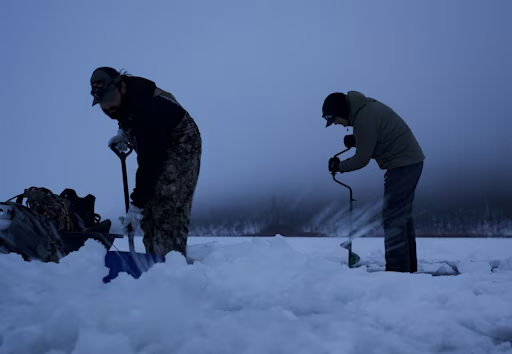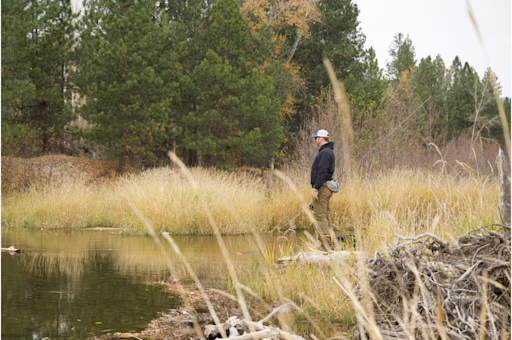How to fish spring runoff
Learn tips to fish rivers when spring snowmelt has them high, dirty and seemingly hopeless.
Share this article

At the tail of winter, cabin fever has set in for a lot of angler and no amount of fishing videos can scratch the itch any more. Spring and ice out can be ideal times to hit the water, but for anyone fishing rivers and creeks spring run off can still stand between you and wetting a line.
Run off refers to the surges and fluctuations that affect a river when spring temperatures melt surrounding snowpacks. Runoff is advantageous to a river as it can reroute the water flow and add nutrients which benefit fish, but it can be one of the most difficult times of year to set a hook.
Fluctuating river heights, changing water temperatures and chocolate milk-colored water all mean an uphill battle in catching a fish. There are, however, specific places to target and conditions to watch for that can offer fishing spots you will have all to yourself.
Disclaimer: Fishing during runoff can be perilous and the utmost safety should always be considered first.
Find the braids

Snow melt can fill a river fast, leaving main stems blown out with off colored water and fast moving water. Braided channels will fill with less water than the main river. These braids are often overlooked during summer and fall, because of low (often unfishable) water levels, but during early runoff braids fill with the perfect amount of water.
Baitfish will often migrate into braids during runoff to avoid the turbulent watts in the mainstem and predatory fish like trout, pike and smallmouth will often follow.
Braids often have great structure to fish, like cut banks and overhanging trees. These targets, plus the new volume of water in the braid offer fish security and will leave them less stressed than low water periods.
Watch the gauges like a hawk

River gauges are your best friend during runoff. Experienced anglers will know the exact height, or volume (measured in cubic feet per second) a river reaches when it becomes unfishable. Anglers who don’t know these metrics need to pay close attention to the Fishbrain River Gauges to look for spikes in the water levels of your favorite river sections.
Because of the fluctuating temperatures of spring, you should also pay attention to a cold night’s effect on water levels. One cold night can refreeze melting snow, putting a pause to raising levels. The pause in rising water can clear up clarity and slow down currents just enough to present water that fish are willing to feed in.
Tailwaters and dams

Tailwaters refer to rivers, creeks and streams that are influenced by the dams. Tailwaters, opposed to freestone rivers which have no obstructions, are at the mercy of controlled flow rates, making them less likely to be blown out and dirty from sediment.
Even when the dams do release extra water during runoff the downriver system is still far more fishable and often your best bet. The deep pools just below dams are often great habitat for large fish, as well. The depth of the pool offers plenty of cover for certain species to proliferate and grow large.
Search the edges
The center of a river is the most affected by high water runoff. This turbulent water will wreak havoc on fish’s ability to seek cover in these areas, thus forcing them to seek calmer waters near the bank. Cut banks, overhanging grass, bushes and trees are all going to replace large boulders, or logs fish use for cover in the middle of the river.
Anglers approaching a river, or creek, this time of year should be extra sneaky even going so far as to knee walking toward a proper casting position. Most of the stream’s fish will be held up along the bank and if you give your position away, or cast a glaring shadow over the water, the spot will be blown before you even make a cast.
The pull of spring fishing is often stronger than our own better judgment. If you’re looking to get some fishing in during spring runoff this year always use extreme caution when getting in, or near the water. Every single year the highwater comes down to fishable levels, so if you’re unsure about the conditions, stay home, stay safe, wait it out and live to fish another day.
But if the conditions are right and you can find that safe place to cast, spring runoff can produce some great days and great fish.
Now let’s go fishing. We’ll provide the river gauges.
If you haven't experienced the #1 fishing app worldwide, make sure and check out Fishbrain to see all the fish data, fishing spots, weather conditions you've been missing out on plus much more.

Download the Fishbrain app and access the best fishing spots in your area
Related blog posts
Master the hardwater season with advanced ice fishing tips . Learn how to find fish faster, refine your search and adjust presentations to catch more fish all winter long.

Your guide to Victoria’s best fish to catch in rivers, lakes, and coastal waters. Learn prime species, fishing tips, and key regulations

Learn how fish adapt as water temperatures cool from autumn to winter, including changes in behavior, metabolism, and habitat that help them survive.




